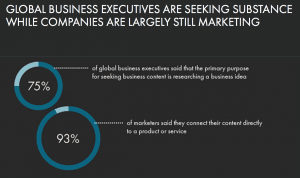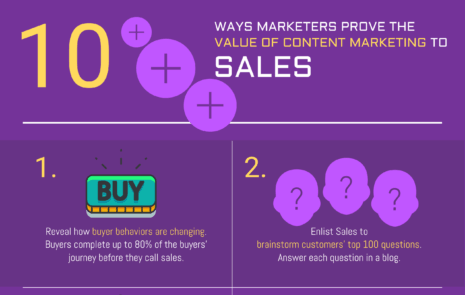
3 Content Marketing Blind Spots Where Accidents Begin
As you drive, risks arise in your blind spots:
• That car that you didn’t see just behind you in the right lane.
• That bicycle lying on the sidewalk.
• That pedestrian who stepped into traffic from behind a tractor-trailer.
While most marketers are doing more and more content marketing, many are blissfully unaware of their own blind spots.
Before accidents happen, here’s how to overcome 3 content marketing blind spots — before it’s too late.
1.) The company-first blind spot. There’s a big disconnect between what buyers are looking for and what marketers offer. Buyers hunt for ideas, but marketers push products.

That’s the finding of a recent report from The Economist and peppercorn, which finds that most marketers are missing the mark in content marketing:
• 75% of executives say their main reason for seeking content marketing is to find ideas.
• But 93% of marketers use content marketing to push products.
• 67% of executives say that unique and timely content improves their perceptions of your brand.
• But 71% don’t like content that feels like a sales pitch.
Remember, helpful information is the engine that keeps content marketing going. Help before you sell.
The truth is, customers don’t really care about you or your products. They care about finding ideas to solve their own problems.
Customers are looking in your content marketing for:
• People whose jobs look like their own
• Problems that look like the problem they’re trying to solve
• Solutions that are proven to work in their industry or size of business.
Will they find what they’re looking for in your content?
While customers come looking for ideas, on many websites they find a menu of content that begins with “Products” and “Services.” Not “Ideas” or “Answers.”
Even worse, many product pages begin with brag and boast: “We are the leader” or “We’re #1.” Brag and boast advertising has never, ever worked.
Brag-and-boast content marketing is a terrible idea.
Studies show that bragging just doesn’t work. Self-promoters always overestimate the positive reaction they will get from an audience.
Bragging is off-putting, in real life and in your content. It offers no benefit to customers, no answer to their question, “What’s in it for me?”
By not addressing the basic questions that buyers ask, marketers miss the chance to frame buyers’ problems and present ideas that solve them. On technical products, marketers often presume way too much knowledge on the part of buyers – suffering from the “curse of knowledge.”

Another problem area on websites is the “About Us” page. “About Us” becomes a license to talk about “we, we, we.”
Most “About Us” webpages recite a history of the company, how old the company is, how big the company is in employees and revenue, how many countries it operates in and the products it offers. It’s all about the company, not at all about the customer.
There’s another path you can take with About Us pages: Tell your origin story in a compelling way, as Fiat does in retelling the Chrysler origin story.
https://youtu.be/Oicu39lda0E
A handful of companies pay heartfelt tribute to their founder, who guided the business with principles and values it still follows. When those values include putting the customers first, remember to tell customers on your “About Us” page.
Use this simple test to see if your content truly puts customers first.
Take your 5 top web pages (based on page views in Google Analytics) and count the number of times the copy refers to customers by name, “customers” or “you.” Then count the number of times you refer to your company name, “the corporation” or “we.”
Mentions of customers should outnumber mentions of your organization by at least 2 to 1. If not, you’ve got a “company-first” problem lurking in your blind spot.
2.) The buyer persona blind spot. Too often marketing conjures up a picture of its audience based on a few distant, imaginary impressions.
You can’t know your audience until you spend enough time with customers. Take the time to know your customers well, so you can market to people you know.
Deal directly with your customers. Meet customers face to face, as often as possible. Do telephone interviews. Meet them at trade shows.
Learn your customers’ language and, most of all, their questions.
Do the work to create solid buyer personas. Buyer personas tell you the specifics you need to know before you can create effective content marketing:
• Which events and people set decision making in motion
• What changes buyers expected to gain after the purchase
• What prevented buyers from addressing the problem sooner
• What buyers wanted to learn
• Which specific capabilities were most important to buyers
• Who was involved in the decision
• What buyers did to evaluate options.
When you know the answers to all these customer questions, you’ve successfully eliminated your buyer persona blind spot. As buyers’ behaviors change, make sure to update your personas – at least every year.
3.) The buyers’ journey blind spot. Buyers take 4 specific steps during carefully considered purchases (but not necessarily in this order).
Yet, most content marketing doesn’t offer what buyers need to get through 4 buying steps.
First, buyers recognize their needs. Marketers, you can help buyers figure out whether they have a problem, how serious it is, and whether they need to change the status quo.
You can win by helping buyers diagnose the problem well. Most content marketing don’t bother with this crucial first step, so here’s a great opportunity to set your content apart.
Next, buyers evaluate options and make a long list of sellers. Buyers ask questions such as:
• Which solution performs better?
• Who provides better service?
• Which has a lower price?
• What are the trade-offs?
You can help buyers win with content that makes it easy to compare options – both within your product line and with your competitors’ lines. Make sure you differentiate clearly among buyers’ options.
Then, buyers trim the long list of sellers to a short list. Buyers narrow to a short list of sellers, and act to resolve any lingering concerns about the short list.
At this stage, buyers seek all the verification they can find from third parties. They want proof, including face-to-face visits with your reference customers.
You can build credibility with content marketing such as case histories and third-party testimonials from peers, as well as trade media news and industry analyst coverage.
Finally, buyers sign a contract. Now, it’s time for content marketing to reinforce the buyers’ decision. Also, start to upsell add-on products and services, and position other solutions for future cross-selling.
Great content marketing:
• Focuses on buyers first
• Starts where the buyer begins, looking for an idea to solve a problem
• Logically walks buyers through all their questions, start to finish
• Helps before it sells.
Do buyers get lost in your content marketing blind spots?
We’re here to help you. When you need to perform content audits, develop B2B content marketing strategy, research buyer personas, create message maps, and execute content marketing that works, call Crystal Clear Communications.
Contact Us





